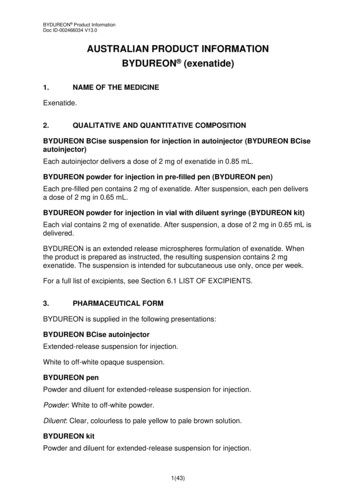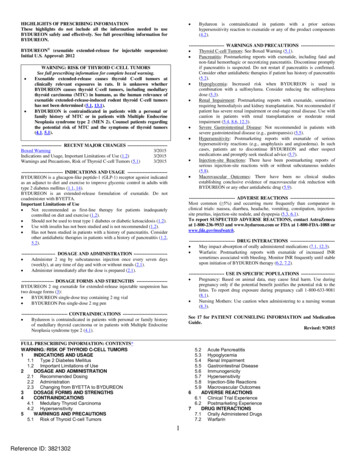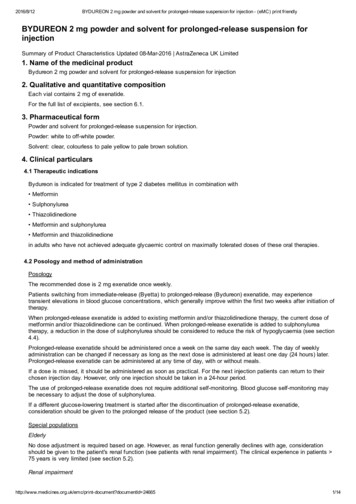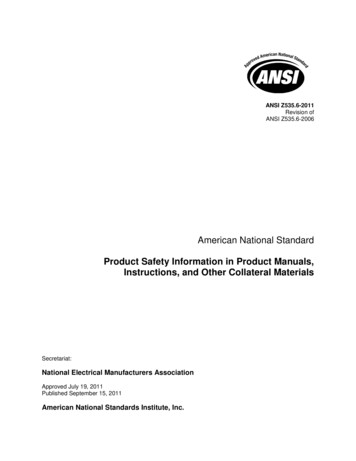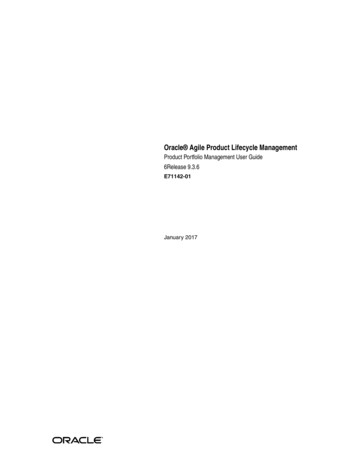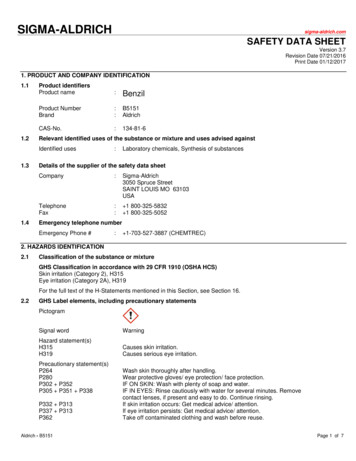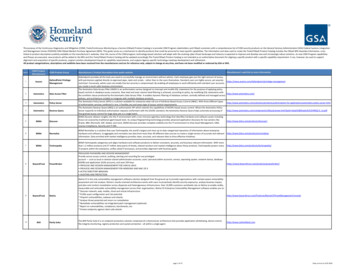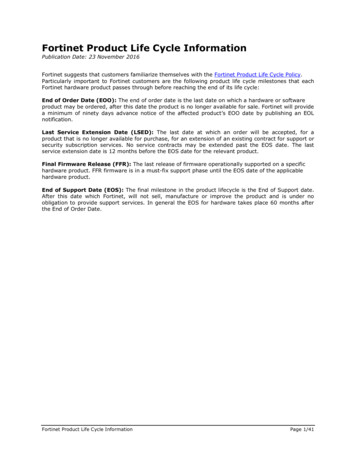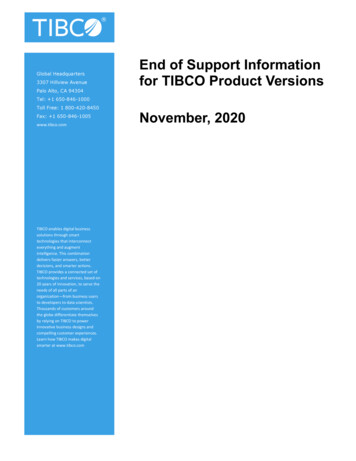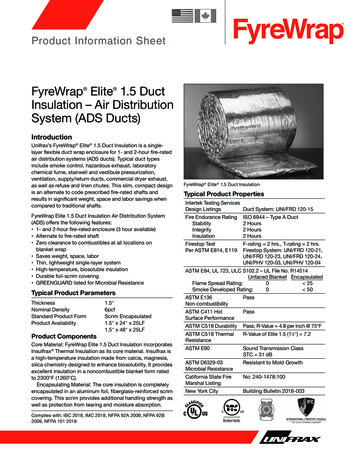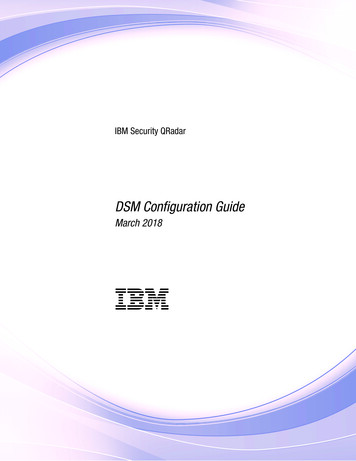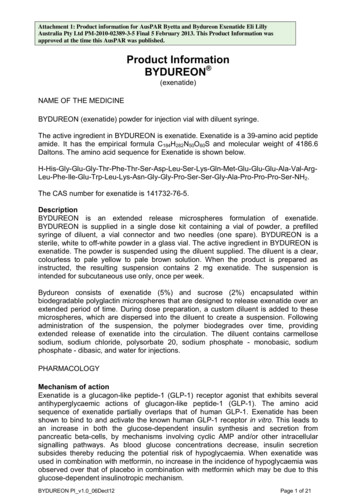
Transcription
Attachment 1: Product information for AusPAR Byetta and Bydureon Exenatide Eli LillyAustralia Pty Ltd PM-2010-02389-3-5 Final 5 February 2013. This Product Information wasapproved at the time this AusPAR was published.Product InformationBYDUREON (exenatide)NAME OF THE MEDICINEBYDUREON (exenatide) powder for injection vial with diluent syringe.The active ingredient in BYDUREON is exenatide. Exenatide is a 39-amino acid peptideamide. It has the empirical formula C184H282N50O60S and molecular weight of 4186.6Daltons. The amino acid sequence for Exenatide is shown -Pro-Pro-Ser-NH2.The CAS number for exenatide is 141732-76-5.DescriptionBYDUREON is an extended release microspheres formulation of exenatide.BYDUREON is supplied in a single dose kit containing a vial of powder, a prefilledsyringe of diluent, a vial connector and two needles (one spare). BYDUREON is asterile, white to off-white powder in a glass vial. The active ingredient in BYDUREON isexenatide. The powder is suspended using the diluent supplied. The diluent is a clear,colourless to pale yellow to pale brown solution. When the product is prepared asinstructed, the resulting suspension contains 2 mg exenatide. The suspension isintended for subcutaneous use only, once per week.Bydureon consists of exenatide (5%) and sucrose (2%) encapsulated withinbiodegradable polyglactin microspheres that are designed to release exenatide over anextended period of time. During dose preparation, a custom diluent is added to thesemicrospheres, which are dispersed into the diluent to create a suspension. Followingadministration of the suspension, the polymer biodegrades over time, providingextended release of exenatide into the circulation. The diluent contains carmellosesodium, sodium chloride, polysorbate 20, sodium phosphate - monobasic, sodiumphosphate - dibasic, and water for injections.PHARMACOLOGYMechanism of actionExenatide is a glucagon-like peptide-1 (GLP-1) receptor agonist that exhibits severalantihyperglycaemic actions of glucagon-like peptide-1 (GLP-1). The amino acidsequence of exenatide partially overlaps that of human GLP-1. Exenatide has beenshown to bind to and activate the known human GLP-1 receptor in vitro. This leads toan increase in both the glucose-dependent insulin synthesis and secretion frompancreatic beta-cells, by mechanisms involving cyclic AMP and/or other intracellularsignalling pathways. As blood glucose concentrations decrease, insulin secretionsubsides thereby reducing the potential risk of hypoglycaemia. When exenatide wasused in combination with metformin, no increase in the incidence of hypoglycaemia wasobserved over that of placebo in combination with metformin which may be due to thisglucose-dependent insulinotropic mechanism.BYDUREON PI v1.0 06Dect12Page 1 of 21
Attachment 1: Product information for AusPAR Byetta and Bydureon Exenatide Eli LillyAustralia Pty Ltd PM-2010-02389-3-5 Final 5 February 2013. This Product Information wasapproved at the time this AusPAR was published.Exenatide suppresses glucagon secretion which is known to be inappropriately elevatedin type 2 diabetes. Lower glucagon concentrations lead to decreased hepatic glucoseoutput. However, exenatide does not impair the normal glucagon response and otherhormone responses to hypoglycaemia.Exenatide slows gastric emptying thereby reducing the rate at which meal-derivedglucose appears in the circulation.Pharmacodynamic effectsExenatide improves glycaemic control through the immediate and sustained effects oflowering both postprandial and fasting glucose concentrations in patients with type 2diabetes. These pharmacodynamic actions occur through various mechanismsincluding stimulation of insulin secretion during hyperglycaemia, suppression ofglucagon, and slowing of gastric emptying. BYDUREON has a pharmacokinetic andpharmacodynamic profile in humans suitable for once weekly administration.A pharmacodynamic study with exenatide demonstrated in patients with type 2 diabetes(n 13) a restoration of first phase insulin secretion and improved second phase insulinsecretion in response to an intravenous bolus of glucose.Glucose-dependent insulin secretion: exenatide has acute effects on pancreaticbeta-cell responsiveness to glucose leading to insulin release predominantly in thepresence of elevated glucose concentrations. This insulin secretion subsides as bloodglucose concentrations decrease and approach euglycemia. Exenatide does not impairthe normal glucagon response to hypoglycemia.First-phase insulin response: In healthy individuals, robust insulin secretion occursduring the first 10 minutes following intravenous (IV) glucose administration. Thissecretion, known as the “first-phase insulin response”, is characteristically absent inpatients with type 2 diabetes. The loss of the first-phase insulin response is an earlybeta-cell defect in type 2 diabetes. Administration of exenatide at therapeutic plasmaconcentrations restored first-phase insulin response to an IV bolus of glucose in patientswith type 2 diabetes (Figure 1). Both first-phase insulin secretion and second-phaseinsulin secretion were significantly increased in patients with type 2 diabetes treatedwith exenatide compared with saline (p 0.001 for both).BYDUREON PI v1.0 06Dect12Page 2 of 21
Attachment 1: Product information for AusPAR Byetta and Bydureon Exenatide Eli LillyAustralia Pty Ltd PM-2010-02389-3-5 Final 5 February 2013. This Product Information wasapproved at the time this AusPAR was published.First-PhaseInsulin Response30Second-PhaseInsulin ResponseInsulin Secretion Rate(pmol kg-1 min-1)2520151050-300306090120Time (min)IV GlucoseBolusExenatide (Type 2 Diabetes), N 13Saline (Type 2 Diabetes), N 13Saline (Healthy), N 12Patients received an IV infusion of insulin for 6.5h (discontinued at [t] -30 min) to normalize plasma glucoseconcentrations and a continuous IV infusion of either exenatide or saline for 5h beginning 3h prior to an IV bolus ofglucose (0.3 g/kg over 30 sec) at t 0 min.Figure 1:Mean (SE) Insulin Secretion Rate During Infusion of Exenatide or Saline in PatientsWith Type 2 Diabetes and During Infusion of Saline in Healthy PatientsGlucagon secretion: In patients with type 2 diabetes, exenatide moderates glucagonsecretion and lowers serum glucagon concentrations during periods of hyperglycaemia.Lower glucagon concentrations lead to decreased hepatic glucose output anddecreased insulin demand.Beta-cell function: exenatide stimulates insulin release – clinical trial data with exenatidetwice daily show that this happens acutely with benefits in glycosylated haemoglobinevident within six weeks. No clinical data are available to suggest an improvement overtime in beta-cell function. In studies of exenatide twice daily, most clinical benefit inglycaemic control was seen within 12 weeks of commencement. An increase inpancreatic islet cell mass has not been consistently demonstrated in animal models.PharmacokineticsThe absorption properties of exenatide reflect the extended release properties of theBYDUREON formulation. Once absorbed into the circulation, exenatide is distributedand eliminated according to its known systemic pharmacokinetic properties (asdescribed in this section).AbsorptionA single dose of BYDUREON exhibits multiphasic release over an approximately 10week period. This is interpretable as an initial period involving the release of surfacebound exenatide followed by 2 subsequent peaks representing the hydration anderosion of the microspheres. However, there are significant interindividual variations inrelease as shown below in terms of mean (figure left) and individual plasma levels(figure right) reflecting large inherent variability in release from the dose form:BYDUREON PI v1.0 06Dect12Page 3 of 21
Attachment 1: Product information for AusPAR Byetta and Bydureon Exenatide Eli LillyAustralia Pty Ltd PM-2010-02389-3-5 Final 5 February 2013. This Product Information wasapproved at the time this AusPAR was published.Figure 2:Extended Release Profile of Single Doses of BYDUREON, Mean (left) and IndividualPlasma Concentrations (right)Following weekly administration of 2mg exenatide once weekly to patients with type 2diabetes, mean drug concentrations exceeded minimal efficacious concentrations ( 50pg/mL) in 2 weeks with gradual increase in the average plasma exenatide concentrationover 6 to 7 weeks. Subsequently, exenatide concentrations of approximately 300 pg/mLwere maintained indicating that steady-state was achieved. Steady-state drugconcentrations are maintained during the one week interval between doses with minimalpeak to trough fluctuation from this average therapeutic concentration. Thebioavailability of BYDUREON was approximately 25% (i.e. systemic exposure is 500microgram per week) compared with the immediate release formulation, BYETTA at 10μg bid gives an exposure of 140microgram/week.DistributionThe mean apparent volume of distribution of exenatide following subcutaneousadministration of a single dose of exenatide is 28.3 LMetabolism and EliminationNonclinical studies have shown that exenatide is predominantly eliminated byglomerular filtration with subsequent proteolytic degradation. The mean apparentclearance of exenatide in humans is 9.1 L/h and the mean terminal half-life is 2.4 h.These pharmacokinetic characteristics of exenatide are independent of the dose.Approximately 10 weeks after discontinuation of exenatide once weekly therapy, meanplasma exenatide concentrations fell below minimal detectable concentrations.Special populationsPatients with renal impairmentNo clinically meaningful differences were observed in steady state exenatideconcentrations or tolerability in patients with mild to moderate renal impairment(creatinine clearance 30 to 80 mL/min) compared to those with normal renal function.No dosage adjustment of 2 mg exenatide once weekly is required for patients with mildto moderate renal impairment. Exenatide once weekly is not recommended for patientswith severe renal impairment (creatinine clearance 30 mL/min) or for patients with endstage renal disease receiving dialysis (see PRECAUTIONS, CONTRAINDICATIONSand DOSAGE AND ADMINISTRATION).BYDUREON PI v1.0 06Dect12Page 4 of 21
Attachment 1: Product information for AusPAR Byetta and Bydureon Exenatide Eli LillyAustralia Pty Ltd PM-2010-02389-3-5 Final 5 February 2013. This Product Information wasapproved at the time this AusPAR was published.Patients with hepatic insufficiencyNo pharmacokinetic study has been performed in patients with a diagnosis of acute orchronic hepatic insufficiency. Exenatide is cleared primarily by the kidney; thereforehepatic dysfunction is not expected to affect blood concentrations of exenatide.Gender, race and body weightGender, race and body weight have no clinically relevant influence on exenatidepharmacokinetics.ElderlyData in elderly are limited, but suggest no marked changes in exenatide exposure withincreased age up to about 75 years old.In a pharmacokinetic study of exenatide twice daily in patients with type 2 diabetes,administration of 10 µg exenatide twice daily resulted in a mean increase of exenatideAUC by 36% in 15 elderly subjects aged 75 to 85 years compared to 15 subjects aged45 to 65 years likely related to reduced renal function in the older age group (seeDOSAGE AND ADMINISTRATION).CLINICAL TRIALSPatients with Type 2 Diabetes participated in 4 long term, randomised, comparatorcontrolled, clinical studies of 2mg exenatide once weekly up to 52 weeks duration (3studies were open label and 1 was double-blind). These studies were conducted toevaluate the efficacy and safety of 2 mg exenatide once weekly compared to either 10µg exenatide twice daily, insulin glargine once daily, or pioglitazone or sitagliptin oncedaily, in both treatment naive patients and those on background therapy with metforminand/or sulfonylurea and/or thiazolidinedione. A total of 1628 patients were includedacross the 5 studies, 804 of which were treated with 2 mg exenatide once weekly, 54%of all study participants were men and 141 patients treated with 2 mg exenatide onceweekly were 65 years of age.Glycaemic controlIn 24 week and 30 week clinical trials, 2 mg exenatide once weekly was compared to 5µg exenatide twice daily for 4 weeks followed by 10 µg exenatide twice daily (seePHARMACOKINETICS – ABSORPTION for information on relative systemicexposures). A 22 week open labelled extension period followed the 30 week studywhere all patients were treated with 2 mg exenatide once weekly. In both studies,decreases in HbA1c were evident in both treatment groups as early as the firstpost-treatment HbA1c measurement (weeks 4 or 6).Exenatide once weekly resulted in a statistically significant reduction in HbA1c comparedto patients receiving exenatide twice daily, p 0.0001 in the 24 weeks study andp 0.05 in the 30 weeks study respectively.A consistently positive effect of exenatide once weekly and twice daily treated subjectswas observed on HbA1c, regardless of the background anti-diabetic therapy in bothstudies.In a 26 week study 2 mg exenatide once weekly was compared to insulin glargine oncedaily. Both treatment groups had a significant reduction in HbA1c, (p .001) whileBYDUREON PI v1.0 06Dect12Page 5 of 21
Attachment 1: Product information for AusPAR Byetta and Bydureon Exenatide Eli LillyAustralia Pty Ltd PM-2010-02389-3-5 Final 5 February 2013. This Product Information wasapproved at the time this AusPAR was published.exenatide once weekly demonstrated a superior change in HbA1c compared to insulinglargine (p 0.017).In a 26 week double blind study, 2 mg exenatide once weekly was compared tomaximum daily doses of sitagliptin and pioglitazone in subjects also using maximal ornear maximal doses of metformin. All treatment groups had a significant reduction inHbA1c compared to baseline. Exenatide once weekly demonstrated superiority to bothsitagliptin (p 0.00001) and pioglitazone (p 0.0165) with respect to change in HbA1cfrom baseline.Table 1 shows HbA1c results for each of the comparator controlled studies.Table 1. Summary of Change in HbA1c from Baseline to Endpoint for Exenatide 2 mgOnce Weekly Comparator Controlled Studies (intent to treat patients)Mean change from baseline to endpoint( Standard Error)StudyNHbA1c2 mg exenatide once weekly vs. exenatide twice daily - 24 weeks of treatment2 mg exenatide once weekly (QW)129-1.6 ( 0.1)10 µg exenatide twice daily (BID)123-0.9 ( 0.1)Mean difference (95% CI QW-BID)-0.7 (-0.9, -0.4)*2 mg exenatide once weekly vs. exenatide twice daily - 30 weeks of treatment2 mg exenatide once weekly (QW)148-1.9 ( 0.08)10 µg exenatide twice daily (BID)147-1.5 ( 0.08)Mean difference (95% CI QW-BID)-0.33 (-0.54, -0.12)*2 mg exenatide once weekly vs. insulin glargine once daily – 26 weeks of treatment2 mg exenatide once weekly (QW)#Insulin glargine (IG)233-1.5 ( 0.05)223-1.3 ( 0.06)Mean difference (95% CI QW-IG)-0.16 (-0.29, -0.03)*2 mg exenatide once weekly vs. sitagliptin or pioglitazone – 26 weeks of treatment2 mg exenatide once weekly (QW)160-1.6 ( 0.10)100 mg sitagliptin (SG)166-0.9 ( 0.10)165-1.23 ( 0.10)45 mg pioglitazone (Pio) Mean difference (95% CI SG)0.63 (0.37, 0.89)*Mean difference (95% CI Pio) 0.32 (0.06, 0.57)** statistically significant#insulin glargine was dosed using the algorithm described by Yki-Järvinen et al. 2007. The mean dose ofinsulin glargine at the beginning of treatment was 10.1 IU/day rising to 31.1 IU/day for insulin glarginetreated patients based on pairwise comparison using exenatide QWBYDUREON PI v1.0 06Dect12Page 6 of 21
Attachment 1: Product information for AusPAR Byetta and Bydureon Exenatide Eli LillyAustralia Pty Ltd PM-2010-02389-3-5 Final 5 February 2013. This Product Information wasapproved at the time this AusPAR was published.Figure 3: LS Mean (SE) Change in HbA1c (%) from Baseline to Week 52Further reductions in HbA1c were observed for at least 52 weeks in the patientscompleting both the 22 week uncontrolled study extension. The evaluable patients whoswitched from exenatide twice daily to 2 mg exenatide once weekly (n 121) achievedthe same improvement in HbA1c of -2.0%, at the end of the extension period comparedto the initial baseline, as the patients treated with 2 mg exenatide once weekly for 52weeks.Proportion of Patients Achieving TargetAs shown in Table 2, clinically and statistically significantly more patients on 2 mgexenatide once weekly compared to exenatide twice daily patients achieved an HbA1creduction of 7% or 7% in the 24 week and 30 week studies (p 0.0001 and p 0.05respectively). Significantly more patients on 2 mg exenatide once weekly achieved anHbA1c reduction of 7% compared to those receiving 100 mg sitagliptin (p 0.0001) and45 mg pioglitazone (p 0.05).BYDUREON PI v1.0 06Dect12Page 7 of 21
Attachment 1: Product information for AusPAR Byetta and Bydureon Exenatide Eli LillyAustralia Pty Ltd PM-2010-02389-3-5 Final 5 February 2013. This Product Information wasapproved at the time this AusPAR was published.Table 2. Proportion of Subjects (%) Achieving HbA1c less than or equal to 7% forExenatide 2 mg Once Weekly Comparator Controlled Studies (intent to treat patients)Proportion of Patients achievingHbA1c target (%)Study2 mg exenatide once weekly vs. exenatide twice daily - 24 weeks of treatmentNHbA1c 7%2 mg exenatide once weekly (QW)1295810 µg exenatide twice daily (BID)12330*2 mg exenatide once weekly vs. exenatide twice daily - 30 weeks of treatmentNHbA1c 7%2 mg exenatide once weekly (QW)1487310 µg exenatide twice daily (BID)14757*2 mg exenatide once weekly vs. insulin glargine once daily – 26 weeks of treatment2 mg exenatide once weekly (QW)#Insulin glargine (IG)NHbA1c 7%23362223542 mg exenatide once weekly vs. sitagliptin or pioglitazone – 26 weeks of treatmentNHbA1c 7%2 mg exenatide once weekly (QW)16062100 mg sitagliptin (SG)16636*45 mg pioglitazone (Pio)16549**statistically significant#insulin glargine was dosed using the algorithm described by Yki-Järvinen et al. 2007. The mean dose ofinsulin glargine at the beginning of treatment was 10.1 IU/day rising to 31.1 IU/day for insulin glarginetreated patientsBody weightA reduction in body weight compared to baseline has been observed in all 2 mgexenatide once weekly studies. This reduction in body weight was seen in patientstreated with 2 mg exenatide once weekly irrespective of the occurrence of nausea,although the reduction was larger in the group with nausea (mean reduction -2.9 kg to 5.2 kg versus -2.2 kg to -2.9 kg).In studies comparing 2 mg exenatide once weekly to 10 µg exenatide twice daily, bothtreatment arms achieved a reduction in body weight from baseline, although thedifference in the treatment groups was not significant.When compared with insulin glargine treatment, 2 mg exenatide once weekly treatmentsignificantly lowered mean body weight (p .001) and was associated with fewerhypoglycaemic events. Significantly greater weight reduction was also achievedcompared to sitagliptin (p 0.0002). Patients on pioglitazone gained weight (p 0.0001)(see table 3).BYDUREON PI v1.0 06Dect12Page 8 of 21
Attachment 1: Product information for AusPAR Byetta and Bydureon Exenatide Eli LillyAustralia Pty Ltd PM-2010-02389-3-5 Final 5 February 2013. This Product Information wasapproved at the time this AusPAR was published.Table 3. Change in Body Weight from Baseline to Endpoint for Exenatide 2 mg OnceWeekly Comparator Controlled Studies (intent to treat patients)Mean change from baseline to endpoint( Standard Error)StudyNKg2 mg exenatide once weekly vs. exenatide twice daily - 24 weeks of treatment2 mg exenatide once weekly (QW)129-2.3 ( 0.4)10 µg exenatide twice daily (BID)123-1.4 ( 0.4)Mean difference (95% CI QW-BID)-1.0 (-1.9, 0.01)2 mg exenatide once weekl
BYDUREON is an extended release microspheres formulation of exenatide. BYDUREON is supplied in a single dose kit containing a vial of powder, a prefilled syringe of diluent, a vial connector and two needles (one spare). BYDUREON is a sterile, white to off-white powder in a glass vial
